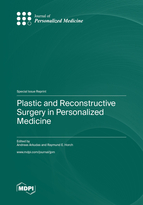Plastic and Reconstructive Surgery in Personalized Medicine
A special issue of Journal of Personalized Medicine (ISSN 2075-4426). This special issue belongs to the section "Methodology, Drug and Device Discovery".
Deadline for manuscript submissions: closed (15 May 2022) | Viewed by 52218
Special Issue Editors
Interests: microsurgery; flap surgery; hand surgery; reconstructive surgery; tissue engineering; biofabrication
Special Issues, Collections and Topics in MDPI journals
Interests: microsurgery; flap surgery; hand surgery; reconstructive surgery; tissue engineering; biofabrication
Special Issues, Collections and Topics in MDPI journals
Special Issue Information
Dear Colleagues,
Plastic and reconstructive surgery has a broad spectrum of different reconstructive techniques including split skin transplantation and local and free flaps. By means of microsurgery and perforator flaps, every reconstructive issue can be addressed by tailored techniques. Flaps can comprise different tissues and can be designed using new imaging technologies in order to increase the safety of the procedures and to retain the form and function of the reconstructed area in accordance with the donor site morbidity.
This Special Issue of the Journal of Personalized Medicine focuses on the following topics:
- Individualized microsurgery;
- Flap imaging;
- Customized perforator flaps;
- Monitoring flap perfusion;
- Tailored tissue engineering for reconstruction;
- Biofabrication applications in personalized plastic and reconstructive surgery.
Please submit your article with your latest achievements in these fields to the journal.
Prof. Dr. Andreas Arkudas
Prof. Dr. Raymund Horch
Guest Editors
Manuscript Submission Information
Manuscripts should be submitted online at www.mdpi.com by registering and logging in to this website. Once you are registered, click here to go to the submission form. Manuscripts can be submitted until the deadline. All submissions that pass pre-check are peer-reviewed. Accepted papers will be published continuously in the journal (as soon as accepted) and will be listed together on the special issue website. Research articles, review articles as well as short communications are invited. For planned papers, a title and short abstract (about 100 words) can be sent to the Editorial Office for announcement on this website.
Submitted manuscripts should not have been published previously, nor be under consideration for publication elsewhere (except conference proceedings papers). All manuscripts are thoroughly refereed through a single-blind peer-review process. A guide for authors and other relevant information for submission of manuscripts is available on the Instructions for Authors page. Journal of Personalized Medicine is an international peer-reviewed open access monthly journal published by MDPI.
Please visit the Instructions for Authors page before submitting a manuscript. The Article Processing Charge (APC) for publication in this open access journal is 2600 CHF (Swiss Francs). Submitted papers should be well formatted and use good English. Authors may use MDPI's English editing service prior to publication or during author revisions.
Keywords
- microsurgery
- flap imaging
- perforator flaps








